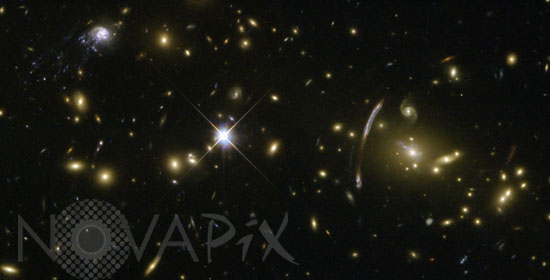Photo Agency - Astronomy - Space - Nature

Galaxy cluster Abell 2667
author: ESA/Nasa/LAM/Novapix
reference: a-amg90-00200
Image Size 300 DPI: 27 * 14 cm
The NASA/ESA Hubble Space Telescope, in collaboration with several other ground- and space-based telescopes, has captured a galaxy being ripped apart by a galaxy cluster's gravitational field and harsh environment. The finding sheds light on the mysterious process by which gas-rich spiral-shaped galaxies might evolve into gas-poor irregular- or elliptical-shaped galaxies over billions of years. The new observations also show one mechanism to form the millions of `homeless` stars seen scattered throughout galaxy clusters. While looking at the galaxy cluster Abell 2667, astronomers found an odd-looking spiral galaxy (shown here in the upper left hand corner of the image) that ploughs through the cluster after being accelerated to at least 3.5 million km/h by the enormous combined gravity of the cluster's dark matter, hot gas and hundreds of galaxies. As the galaxy speeds through, its gas and stars are being stripped away by the tidal forces exerted by the cluster just as the tidal forces exerted by the moon and Sun push and pull the Earth's oceans. Also contributing to this destructive process is the pressure of the cluster's hot gas plasma reaching temperatures as high as 10-100 million degrees. Both processes the tidal forces and the aptly named `ram pressure stripping` resulting from the action of the hot cluster gas resemble those affecting comets in our Solar System. For this reason, scientists have nicknamed this peculiar spiral with its tail the `Comet Galaxy`. Even though its mass is slightly larger than that of the Milky Way, the spiral will inevitably lose all its gas and dust as well as its chance of generating new stars later, and become a gas-poor galaxy with an old population of red stars. Scientists estimate that the total duration of the transformation process is close to one billion years. What is seen now in the Hubble image is roughly 200 million years into the process. The strong gravitational pull exerted by the galaxy cluster's collective mass has bent the light of other, more distant galaxies and distorted their shapes an effect called gravitational lensing. The giant bright banana-shaped arc seen just to the left of the cluster centre corresponds to the magnified and distorted image of a distant galaxy that lies behind the cluster's core. At the cluster's centre another rare feature can be seen: the vivid blue light from millions of stars created in a so-called cooling flow. Some of the hot cluster gas is cooling in a filamentary structure as it falls into the cluster's core, setting off the birth of lots of bright blue stars outshining their environment. This may be the clearest picture of this phenomenon yet. The Hubble image was taken by Hubble's Wide Field and Planetary Camera 2 in October 2001. ESO's Very Large Telescope and the twin Keck Telescopes were used for optical spectroscopy and near-infrared photometry, which helped determine the age of the star-forming region. NASA's Spitzer Space Telescope and Chandra X-Ray Observatory were used jointly to confirm that the activity in the `Comet Galaxy` was due to vigorous star-formation and not a super-massive black hole.
Contact : Stéphane Aubin +33-(0)9-51-26-53-76
© Novapix - All rights reserved


